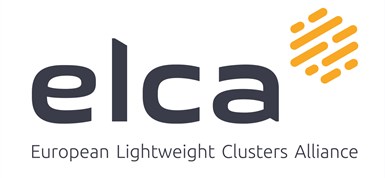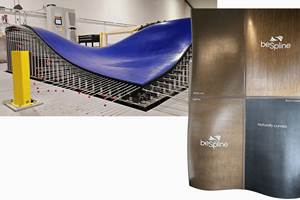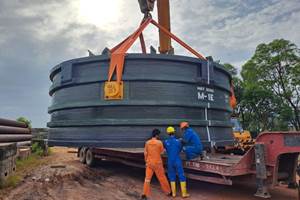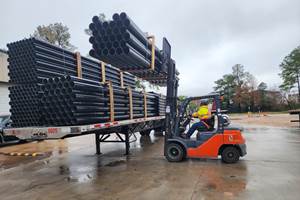AMULET project aims to create new value chains for fiber-reinforced polymers and CMCs
R&D demonstration projects targeting current challenges in auto, aero, energy and building will be developed to reach TRL7 with the goal of accelerating industrial use of advanced lightweight materials.
Photo Credit: AMULET project website, ELCA
To create a decarbonized and efficient circular economy, it is essential to widely establish lightweight construction as a key technology. However, small- and medium-sized enterprises (SMEs) have not yet fully realized the potential of advanced lightweight materials, due to a lack of application knowledge, as well as technical and financial resources.
The trans-European project “Advanced Materials and Manufacturing Technologies united for Lightweight” (AMULET) aims to develop the untapped innovation potential of SMEs in the field of lightweight construction and to help establish new pan-European value chains for advanced lightweight materials. The AMULET consortium is funded by the European Union Horizon 2020 research and innovation program (INNOSUP-1). The project launch meeting was held Sept 6, 2021. AMULET will run until Sept 2024.
The vision of the AMULET consortium is to make a significant contribution to reducing CO2 emissions in the EU by strengthening innovative, lightweight construction in SMEs. R&D demonstration projects targeting current sectoral challenges will be developed to reach technology readiness level (TRL) 7, following a competitive-based approach. SMEs participating in AMULET will receive technical training support and business-to-business coaching for accelerating the commercialization of their innovative solutions. AMULET will focus on the automotive, aerospace, energy and construction industries and support innovative development and application of three advanced lightweight materials:
- Fiber-reinforced polymers (FRPs)
- Ceramic matrix composites (CMC)
- Light metal alloys
Photo Credit: AMULET project flyer, ELCA
AMULET’s three phases
Within AMULET’s first application phase, participants will discuss and evaluate current technical challenges in the use of advanced lightweight materials through expert groups. This will be followed by up to 12 thematic competitions in which the European consortia of SMEs will participate. Matchmaking events on-site in selected partner countries will help form consortia of interested SMEs.
In the second phase, companies that have joined AMULET will complete a feasibility study, and demonstrate their proposed solutions in the third and final phase. Financial and advisory support will be provided and SMEs will be assisted to develop topic-specific technical and business knowledge. A curriculum of at least 12 technical and six business management topics will be developed in the consortium for this purpose and then provided to SMEs via online platforms for the entire duration of the project.
In addition to this learning content, webinars will be offered on each topic area. Individual coaching sessions will also available to exchange personal knowledge. The goal is to make a significant contribution to a more sustainable EU with significantly reduced CO2 emissions.
Photo Credit: AMULET project website, ELCA
The AMULET consortium
Photo Credit: AMULET project website, ELCA.
The AMULET consortium brings together a comprehensive network of more than 1,717 SMEs, 341 large companies and 93 universities and research and innovation institutes.
The AMULET project is coordinated by professors Lothar Kroll and Maximilian Schwarz from the Technical University of Chemnitz (Chemnitz, Germany). Nine ELCA partners are also part of the consortium: Bydgoszcz Industrial Cluster (Poland), Cluster MAV (Spain), Flanders Make (Belgium), Jožef Stefan Institute (Slovenia), IMAST (Italy), Plastipolis (France), Southwest Hungarian Engineering Cluster (Hungary) and Clust-ER MECH (Italy).
For more information, view the and download the , available in English, German and Polish.

AMULET is supported by the (ELCA). The European Green Deal aims to make Europe climate neutral by 2050. Lightweight technologies are key in achieving this goal. Composites provide the highest potential for reducing weight but are encountering bottlenecks for their mass adoption by various sectors, including automotive and construction. The multi-material approach is gaining force, but also presents new challenges in both processing and performance. ELCA is a collaborative initiative that aims to accelerate the adoption of lightweight materials in strategic industries. Mobility is the alliance’s primary focus, but applications in other lightweighting-related sectors are also targeted, including energy, healthcare, defense and construction.
Related Content
Swedish parking garage to incorporate decommissioned wind blades
Architect Jonas Lloyd is working with Vattenfall to design the multistory building with a wind blade façade, targeting eco-friendly buildings and creative ways to remove blades from landfills.
Read MorePlant tour: BeSpline/Addcomp, Sherbrooke, QC, Canada
Composites automation specialist increases access to next-gen technologies, including novel AFP systems and unique 3D parts using adaptive molds.
Read MoreComposites end markets: Infrastructure and construction (2024)
Composites are increasingly used in applications like building facades, bridges, utility poles, wastewater treatment pipes, repair solutions and more.
Read MoreFiberglass conduit manufacturer grows into new products, infrastructure applications
Texas-based Champion Fiberglass, a five-time CW Top Shops honoree, expands its success in the fiberglass composite conduit market into new applications and products, looking toward future automation and sustainability initiatives.
Read MoreRead Next
Scaling up, optimizing the flax fiber composite camper
Greenlander’s Sherpa RV cab, which is largely constructed from flax fiber/bio-epoxy sandwich panels, nears commercial production readiness and next-generation scale-up.
Read MoreCeramic matrix composites: Faster, cheaper, higher temperature
New players proliferate, increasing CMC materials and manufacturing capacity, novel processes and automation to meet demand for higher part volumes and performance.
Read MoreNext-gen fan blades: Hybrid twin RTM, printed sensors, laser shock disassembly
MORPHO project demonstrates blade with 20% faster RTM cure cycle, uses AI-based monitoring for improved maintenance/life cycle management and proves laser shock disassembly for recycling.
Read More












